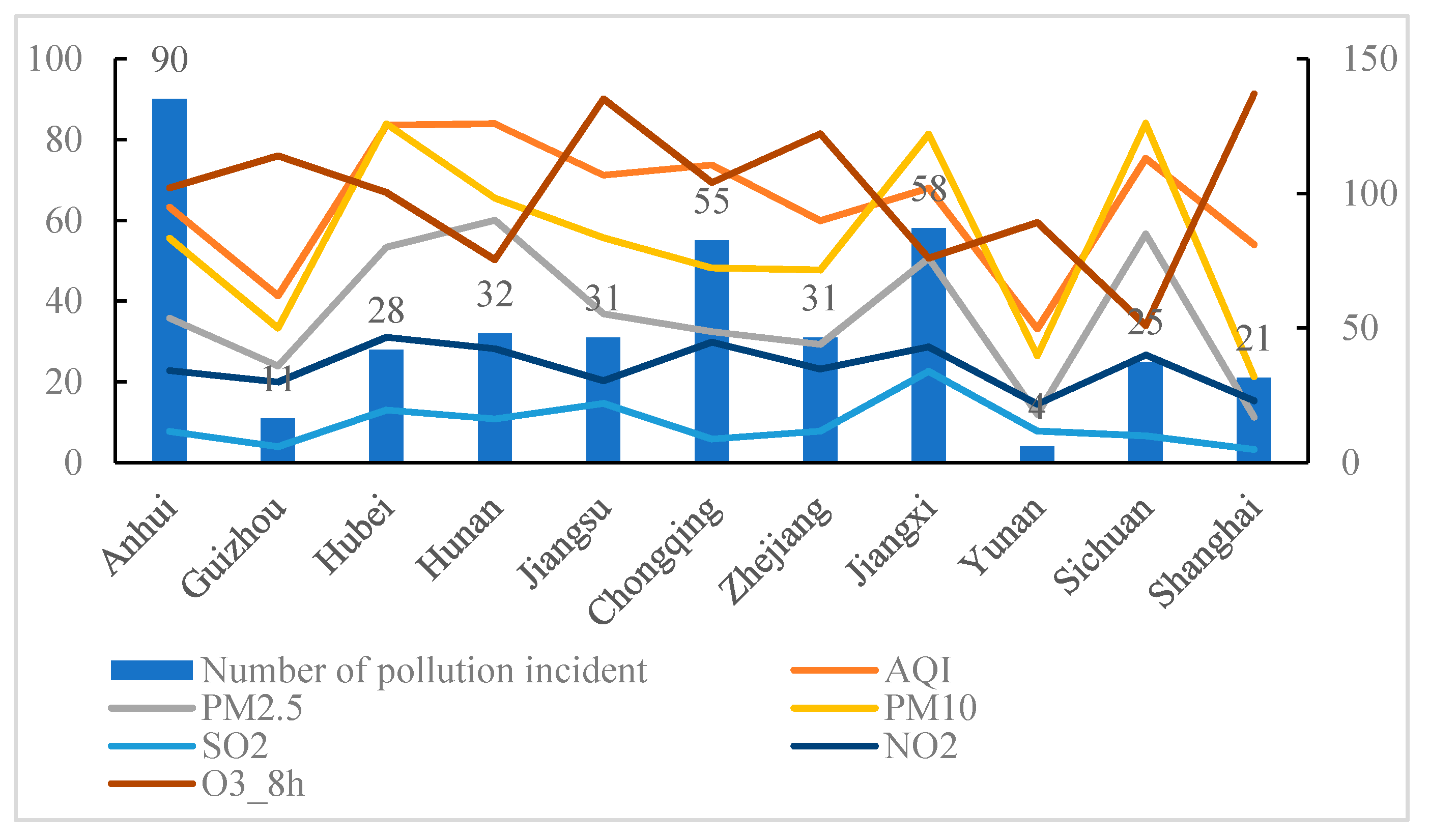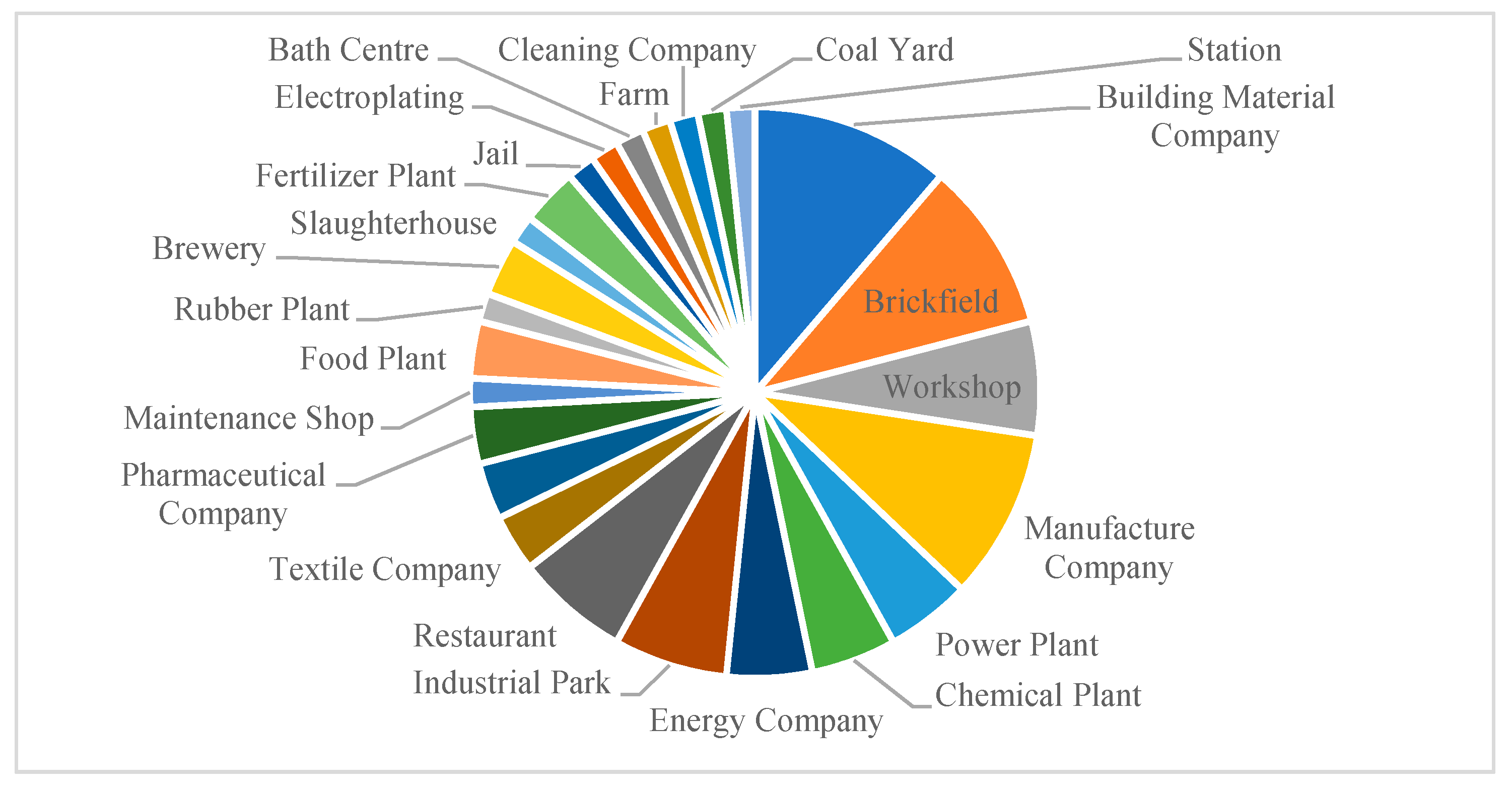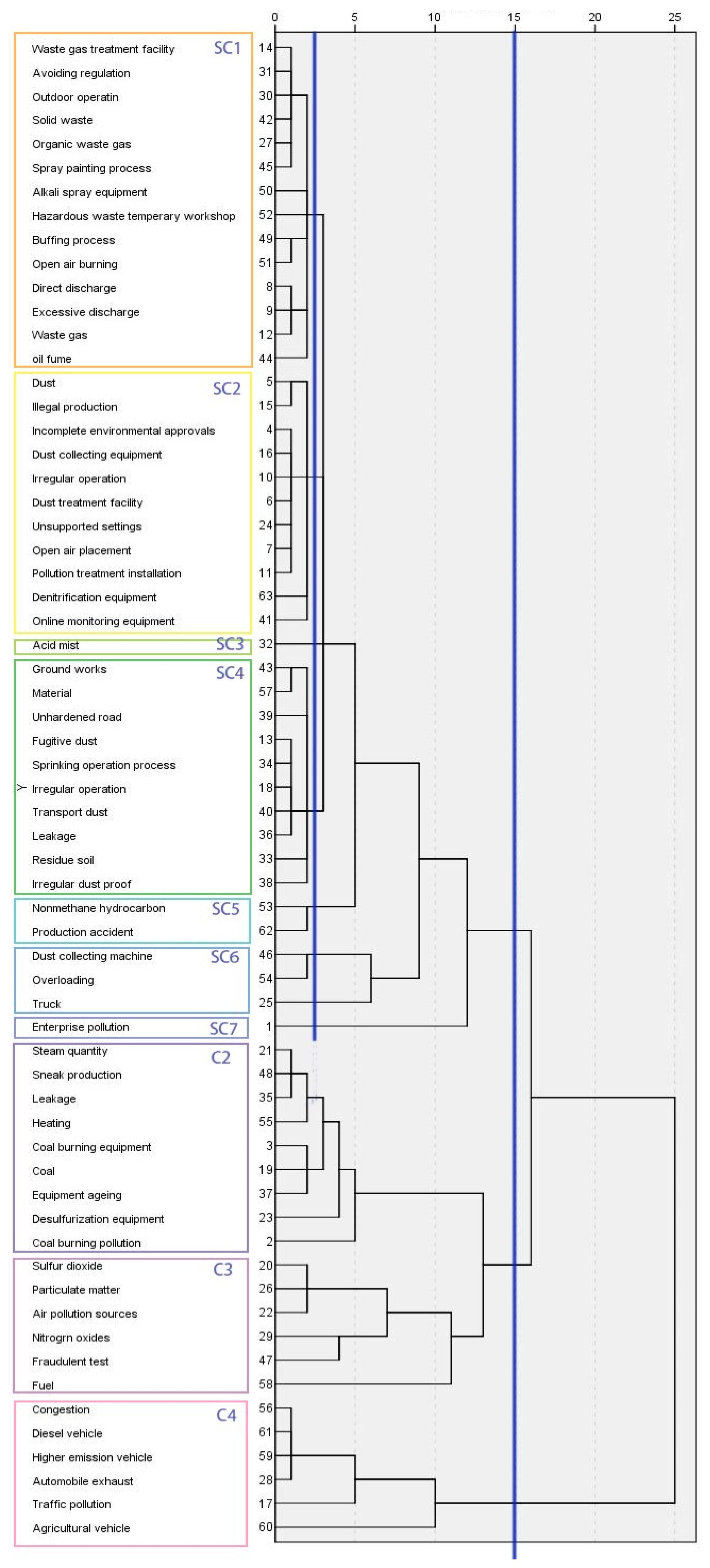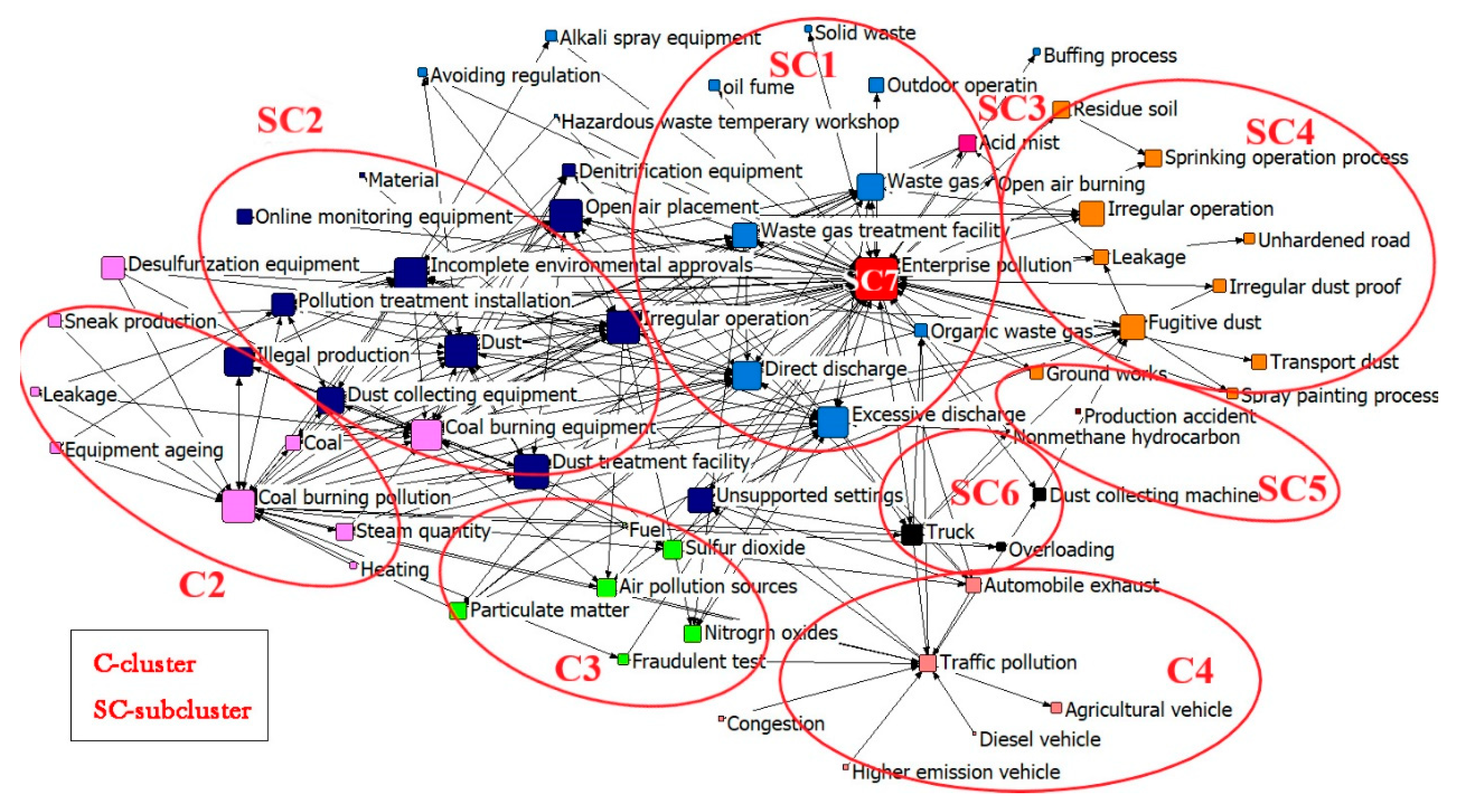Atmospheric Pollution Mapping of the Yangtze River Basin: An AQI-Based Weighted Co-Word Analysis
Abstract
1. Introduction
2. Methodology
2.1. Detection of the Research Theme
2.2. Collection of Raw Data
2.3. Data Processing
2.4. An AQI-Based Weighted Calculation
2.5. Clustering and Visualization
3. Results and Discussion
3.1. Descriptive Statistics
3.2. Frequencies Analysis
3.3. Correlation Matrix
3.4. Clustering
- C1. Enterprise pollution and main pollutants
- C2. Coal-burning and air pollutions
- C3. Various air pollutions
- C4. Traffic and air pollution
3.5. Visualization Mapping
4. Conclusions
Author Contributions
Funding
Conflicts of Interest
References
- Hnatyshyn, M. Decomposition analysis of the impact of economic growth on ammonia and nitrogen oxides emissions in the European Union. J. Int. Stud. 2018, 11, 201–209. [Google Scholar] [CrossRef]
- Galnaitytė, A.; Kriščiukaitienė, I.; Baležentis, T.; Namiotko, V. Evaluation of technological, economic and social indicators of different farming practices in Lithuania. Econ. Sociol. 2017, 10, 189–202. [Google Scholar] [CrossRef] [PubMed]
- Kampa, M.; Castanas, E. Human health effect of air polution-Enviro Polution. Environ. Pollut. 2007, 151, 362–367. [Google Scholar] [CrossRef] [PubMed]
- Qin, T.; Yang, P.; Groves, C.; Chen, F.; Xie, G.; Zhan, Z. Natural and anthropogenic factors affecting geochemistry of the Jialing and Yangtze Rivers in urban Chongqing, SW China. Appl. Geochemistry 2018, 98, 448–458. [Google Scholar] [CrossRef]
- Chen, B.; Yang, S.; Xu, X.D.; Zhang, W. The impacts of urbanization on air quality over the Pearl River Delta in winter: Roles of urban land use and emission distribution. Theor. Appl. Climatol. 2014, 117, 29–39. [Google Scholar] [CrossRef]
- Fan, Q.; Yang, S.; Liu, S. Asymmetrically Spatial Effects of Urban Scale and Agglomeration on Haze Pollution in China. Int. J. Environ. Res. Public Health 2019, 16, 4936. [Google Scholar] [CrossRef]
- Yu, Y.; Wang, J.; Yu, J.; Chen, H.; Liu, M. Spatial and temporal distribution characteristics of PM 2.5 and PM 10 in the urban agglomeration of China’s Yangtze river delta, China. Polish J. Environ. Stud. 2019, 28, 445–452. [Google Scholar] [CrossRef]
- Liu, Y.; Dong, F. How Industrial Transfer Processes Impact on Haze Pollution in China: An Analysis from the Perspective of Spatial Effects. Int. J. Environ. Res. Public Health 2019, 16, 423. [Google Scholar] [CrossRef]
- Wu, J.; Zhang, P.; Yi, H.; Qin, Z. What causes haze pollution? An empirical study of PM2.5 concentrations in Chinese cities. Sustainability 2016, 8, 132. [Google Scholar] [CrossRef]
- Zhou, C.; Chen, J.; Wang, S. Examining the effects of socioeconomic development on fine particulate matter (PM2.5) in China’s cities using spatial regression and the geographical detector technique. Sci. Total Environ. 2018, 619–620, 436–445. [Google Scholar] [CrossRef]
- Xu, B.; Luo, L.; Lin, B. A dynamic analysis of air pollution emissions in China: Evidence from nonparametric additive regression models. Ecol. Indic. 2016, 63, 346–358. [Google Scholar] [CrossRef]
- Tian, X.; Dai, H.; Geng, Y.; Wilson, J.; Wu, R.; Xie, Y.; Hao, H. Economic impacts from PM2.5 pollution-related health effects in China’s road transport sector: A provincial-level analysis. Environ. Int. 2018, 115, 220–229. [Google Scholar] [CrossRef]
- Peters, H.P.F.; van Raan, A.F.J. Co-word-based science maps of chemical engineering. Part I: Representations by direct multidimensional scaling. Res. Policy 1993, 22, 23–45. [Google Scholar] [CrossRef]
- Wang, T.; Jiang, F.; Deng, J.; Shen, Y.; Fu, Q.; Wang, Q.; Fu, Y.; Xu, J.; Zhang, D. Urban air quality and regional haze weather forecast for Yangtze River Delta region. Atmos. Environ. 2012, 58, 70–83. [Google Scholar] [CrossRef]
- Liu, H.; Fang, C.; Zhang, X.; Wang, Z.; Bao, C.; Li, F. The effect of natural and anthropogenic factors on haze pollution in Chinese cities: A spatial econometrics approach. J. Clean. Prod. 2017, 165, 323–333. [Google Scholar] [CrossRef]
- Lu, D.; Xu, J.; Yang, D.; Zhao, J. Spatio-temporal variation and influence factors of PM2.5concentrations in China from 1998 to 2014. Atmos. Pollut. Res. 2017, 8, 1151–1159. [Google Scholar] [CrossRef]
- Li, L.; Qian, J.; Ou, C.Q.; Zhou, Y.X.; Guo, C.; Guo, Y. Spatial and temporal analysis of Air Pollution Index and its timescale-dependent relationship with meteorological factors in Guangzhou, China, 2001-2011. Environ. Pollut. 2014, 190, 75–81. [Google Scholar] [CrossRef]
- Bao, J.; Yang, X.; Zhao, Z.; Wang, Z.; Yu, C.; Li, X. The Spatial-Temporal Characteristics of Air Pollution in China from 2001–2014. Int. J. Environ. Res. Public Health 2015, 12, 15875–15887. [Google Scholar] [CrossRef]
- Mukhtarova, K.S.; Trifilova, A.A.; Zhidebekkyzy, A. Commercialization of green technologies: An exploratory literature review. J. Int. Stud. 2016, 9, 75–87. [Google Scholar] [CrossRef][Green Version]
- Jiang, L.; Zhou, H.F.; Bai, L.; Zhou, P. Does foreign direct investment drive environmental degradation in China? An empirical study based on air quality index from a spatial perspective. J. Clean. Prod. 2018, 176, 864–872. [Google Scholar] [CrossRef]
- Ma, Y.R.; Ji, Q.; Fan, Y. Spatial linkage analysis of the impact of regional economic activities on PM2.5 pollution in China. J. Clean. Prod. 2016, 139, 1157–1167. [Google Scholar] [CrossRef]
- Ma, T.; Duan, F.; He, K.; Qin, Y.; Tong, D.; Geng, G.; Liu, X.; Li, H.; Yang, S.; Ye, S.; et al. Air pollution characteristics and their relationship with emissions and meteorology in the Yangtze River Delta region during 2014–2016. J. Environ. Sci. 2019, 83, 8–20. [Google Scholar] [CrossRef] [PubMed]
- Wang, W.; Yu, J.; Cui, Y.; He, J.; Xue, P.; Cao, W.; Ying, H.; Gao, W.; Yan, Y.; Hu, B.; et al. Characteristics of fine particulate matter and its sources in an industrialized coastal city, Ningbo, Yangtze River Delta, China. Atmos. Res. 2018, 203, 105–117. [Google Scholar] [CrossRef]
- Mou, Y.; Song, Y.; Xu, Q.; He, Q.; Hu, A. Influence of Urban-Growth Pattern on Air Quality in China: A Study of 338 Cities. Int. J. Environ. Res. Public Health 2018, 15, 1805. [Google Scholar] [CrossRef]
- Koziuk, V.; Dluhopolskyi, O.; Farion, A.; Dluhopolska, T. Crony sectors as a barrier to economic well-being and ecologization (Case of Ukraine). Econ. Sociol. 2018, 11, 113–132. [Google Scholar] [CrossRef]
- He, L.; Liu, Y.; He, P.; Zhou, H. Relationship between Air Pollution and Urban Forms: Evidence from Prefecture-Level Cities of the Yangtze River Basin. Int. J. Environ. Res. Public Health 2019, 16, 3459. [Google Scholar] [CrossRef]
- Fan, H.; Zhao, C.; Yang, Y. A comprehensive analysis of the spatio-temporal variation of urban air pollution in China during 2014–2018. Atmos. Environ. 2020, 220, 117066. [Google Scholar] [CrossRef]
- Song, C.; Wu, L.; Xie, Y.; He, J.; Chen, X.; Wang, T.; Lin, Y.; Jin, T.; Wang, A.; Liu, Y.; et al. Air pollution in China: Status and spatiotemporal variations. Environ. Pollut. 2017, 227, 334–347. [Google Scholar] [CrossRef]
- Zhan, D.; Kwan, M.-P.; Zhang, W.; Wang, S.; Yu, J. Spatiotemporal Variations and Driving Factors of Air Pollution in China. Int. J. Environ. Res. Public Health 2017, 14, 1538. [Google Scholar] [CrossRef]
- He, D.; Gao, P.; Sun, Z.; Lau, Y.Y. Measuring water transport efficiency in the Yangtze River Economic Zone, China. Sustainability 2017, 9, 2278. [Google Scholar] [CrossRef]
- Cheng, S.; Xie, J.; Xiao, D.; Zhang, Y. Measuring the Environmental Efficiency and Technology Gap of PM2.5 in China’s Ten City Groups: An Empirical Analysis Using the EBM Meta-Frontier Model. Int. J. Environ. Res. Public Health 2019, 16, 675. [Google Scholar] [CrossRef] [PubMed]
- Zou, B.; You, J.; Lin, Y.; Duan, X.; Zhao, X.; Fang, X.; Campen, M.J.; Li, S. Air pollution intervention and life-saving effect in China. Environ. Int. 2019, 125, 529–541. [Google Scholar] [CrossRef] [PubMed]
- Liu, C.; Chen, R.; Zhao, Y.; Ma, Z.; Bi, J.; Liu, Y.; Meng, X.; Wang, Y.; Chen, X.; Li, W.; et al. Associations between ambient fine particulate air pollution and hypertension: A nationwide cross-sectional study in China. Sci. Total Environ. 2017, 584–585, 869–874. [Google Scholar] [CrossRef] [PubMed]
- Ding, Y.; Chowdhury, G.G.; Foo, S. Bibliometric cartography of information retrieval research by using co-word analysis. Inf. Process. Manag. 2001, 37, 817–842. [Google Scholar] [CrossRef]
- Ravikumar, S.; Agrahari, A.; Singh, S.N. Mapping the intellectual structure of scientometrics: A co-word analysis of the journal scientometrics (2005–2010). Scientometrics 2015, 102, 929–955. [Google Scholar] [CrossRef]
- Benckendorff, P.; Zehrer, A. A network analysis of tourism research. Ann. Tour. Res. 2013. [Google Scholar] [CrossRef]
- Leung, X.Y.; Sun, J.; Bai, B. Bibliometrics of social media research: A co-citation and co-word analysis. Int. J. Hosp. Manag. 2017, 66, 35–45. [Google Scholar] [CrossRef]
- Vogel, R.; Güttel, W.H. The dynamic capability view in strategic management: A bibliometric review. Int. J. Manag. Rev. 2013, 15, 426–446. [Google Scholar] [CrossRef]
- He, Q. Knowledge Discovery Through Co-Word Analysis. Libr. Trends 1999, 48, 133–159. [Google Scholar]
- Wu, D.; Song, Y.; Xie, K.; Zhang, B. Traits and causes of environmental loss-related chemical accidents in China based on co-word analysis. Environ. Sci. Pollut. Res. 2018, 25, 18189–18199. [Google Scholar] [CrossRef]
- Jiang, Z.; Tao, Y. Co-word analysis and bibliometric visualization of translation quality literature: research topics and trends in the Chinese mainland (1997–2016). Asia Pacific Transl. Intercult. Stud. 2018, 5, 250–265. [Google Scholar] [CrossRef]
- Armah, F.A.; Yawson, D.O.; Pappoe, A.A.N.M. A systems dynamics approach to explore traffic congestion and air pollution link in the city of Accra, Ghana. Sustainability 2010, 2, 252–265. [Google Scholar] [CrossRef]
- Tao, Z.; Kokas, A.; Zhang, R.; Cohan, D.S.; Wallach, D. Inferring atmospheric particulate matter concentrations from Chinese social media data. PLoS One 2016, 11. [Google Scholar] [CrossRef] [PubMed]
- Jiang, W.; Wang, Y.; Tsou, M.H.; Fu, X. Using social media to detect outdoor air pollution and monitor air quality index (AQI): A geo-targeted spatiotemporal analysis framework with sina weibo (Chinese twitter). PLoS One 2015, 10. [Google Scholar] [CrossRef]
- Lee, P.-C.; Su, H.-N. Investigating the structure of regional innovation system research through keyword co-occurrence and social network analysis. Innovation 2010, 12, 26–40. [Google Scholar] [CrossRef]
- Aria, M.; Cuccurullo, C. bibliometrix: An R-tool for comprehensive science mapping analysis. J. Informetr. 2017, 11, 959–975. [Google Scholar] [CrossRef]
- Che, H.; Zhang, X.; Li, Y.; Zhou, Z.; Qu, J.J.; Hao, X. Haze trends over the capital cities of 31 provinces in China, 1981-2005. Theor. Appl. Climatol. 2009, 97, 235–242. [Google Scholar] [CrossRef]
- Murtagh, F.; Legendre, P. Ward’s Hierarchical Agglomerative Clustering Method: Which Algorithms Implement Ward’s Criterion? J. Classif. 2014, 31, 274–295. [Google Scholar] [CrossRef]
- Simionescu, M.; Bilan, Y.; Gedek, S.; Streimikiene, D. The effects of greenhouse gas emissions on cereal production in the European Union. Sustainability 2019, 11, 3433. [Google Scholar] [CrossRef]
- Lelieveld, J.; Evans, J.S.; Fnais, M.; Giannadaki, D.; Pozzer, A. The contribution of outdoor air pollution sources to premature mortality on a global scale. Nature 2015, 525, 367–371. [Google Scholar] [CrossRef]
- Vafa-arani, H.; Jahani, S.; Dashti, H.; Heydari, J.; Moazen, S. A system dynamics modeling for urban air pollution: A case study of Tehran, Iran. Transp. Res. PART D 2014, 31, 21–36. [Google Scholar] [CrossRef]
- Tang, D.; Zhang, Y.; Bethel, B.J. An analysis of disparities and driving factors of carbon emissions in the Yangtze River Economic Belt. Sustainability 2019, 11, 2362. [Google Scholar] [CrossRef]
- Sabetghadam, S.; Ahmadi-Givi, F. Relationship of extinction coefficient, air pollution, and meteorological parameters in an urban area during 2007 to 2009. Environ. Sci. Pollut. Res. 2014, 21, 538–547. [Google Scholar] [CrossRef] [PubMed]






| Keyword | Freq. | Keyword | Freq. | Keyword | Freq. |
|---|---|---|---|---|---|
| Enterprise pollution | 256 | Irregular operation | 43 | Automobile exhaust | 17 |
| Coal-burning pollution | 97 | Irregular operation | 43 | Sulfur dioxide | 16 |
| Coal-burning equipment | 72 | Pollution treatment installation | 40 | Organic waste gas | 14 |
| Incomplete environmental approvals | 65 | Waste gas treatment facility | 38 | Steam quantity | 13 |
| Dust | 61 | Fugitive dust | 37 | Truck | 13 |
| Excessive discharge | 61 | Traffic pollution | 34 | Particulate matter | 13 |
| Direct discharge | 57 | Illegal production | 32 | Unsupported settings | 12 |
| Dust treatment facility | 55 | Dust collecting equipment | 30 | Nitrogen oxides | 12 |
| Open air placement | 53 | Air pollution sources | 21 | Desulfurization equipment | 11 |
| Waste gas | 46 | Coal | 18 | Outdoor operation | 8 |
| Keywords | Coal burning Equipment | Incomplete Environmental Approvals | Dust | Dust Treatment Facility | Open Air Placement | Direct Discharge | Excessive Discharge |
|---|---|---|---|---|---|---|---|
| Coal burning equipment | 1.000 | 0.526 * | 0.586 ** | 0.418 ** | 0.411 ** | 0.391 * | 0.297 * |
| Incomplete environmental approvals | 0.176 | 1.000 | 0.904 ** | 0.873 ** | 0.888 ** | 0.832 ** | 0.783 ** |
| Dust | 0.007 | 0.000 | 1.000 | 0.760 ** | 0.802 ** | 0.789 ** | 0.771 ** |
| Dust treatment facility | 0.009 | 0.000 | 0.760 | 1.000 | 0.845 ** | 0.847 ** | 0.813 ** |
| Open air placement | 0.008 | 0.001 | 0.000 | 0.000 | 1.000 | 0.766 ** | 0.746 ** |
| Direct discharge | 0.175 | 0.001 | 0.000 | 0.000 | 0.000 | 1.000 | 0.872 ** |
| Excessive discharge | 0.035 | 0.002 | 0.000 | 0.000 | 0.000 | 0.000 | 1.000 |
© 2020 by the authors. Licensee MDPI, Basel, Switzerland. This article is an open access article distributed under the terms and conditions of the Creative Commons Attribution (CC BY) license (http://creativecommons.org/licenses/by/4.0/).
Share and Cite
Song, Y.; Liu, B.; Chen, X.; Liu, J. Atmospheric Pollution Mapping of the Yangtze River Basin: An AQI-Based Weighted Co-Word Analysis. Int. J. Environ. Res. Public Health 2020, 17, 817. https://doi.org/10.3390/ijerph17030817
Song Y, Liu B, Chen X, Liu J. Atmospheric Pollution Mapping of the Yangtze River Basin: An AQI-Based Weighted Co-Word Analysis. International Journal of Environmental Research and Public Health. 2020; 17(3):817. https://doi.org/10.3390/ijerph17030817
Chicago/Turabian StyleSong, Yu, Bingrui Liu, Xiaohong Chen, and Jia Liu. 2020. "Atmospheric Pollution Mapping of the Yangtze River Basin: An AQI-Based Weighted Co-Word Analysis" International Journal of Environmental Research and Public Health 17, no. 3: 817. https://doi.org/10.3390/ijerph17030817
APA StyleSong, Y., Liu, B., Chen, X., & Liu, J. (2020). Atmospheric Pollution Mapping of the Yangtze River Basin: An AQI-Based Weighted Co-Word Analysis. International Journal of Environmental Research and Public Health, 17(3), 817. https://doi.org/10.3390/ijerph17030817






